A Novel Wind Turbine Clutter Detection Algorithm for Weather Radar Data
Abstract
1. Introduction
2. Data
2.1. Jiangsu Nantong Weather Radar Data
2.2. Wind Turbine Clutter Dataset
3. Wind Turbine Clutter Classification Methodology
3.1. Random Forest Approach
3.2. Feature Importance
4. Training and Optimization of the WTCDA-RF Algorithm
5. Experimental Setup and Results
5.1. Evaluation of the WTCDA-RF Algorithm
- ACC (Equation (8)) represents the proportion of correct predictions within the overall dataset, reflecting the model’s overall accuracy.
- PRE (Equation (9)) indicates the precision of the model, measuring its accuracy in identifying positive samples.
- The F1-score (Equation (10)) is a harmonic mean of precision and recall (with Recall = TP/ (TP + FN)), offering a balanced measure of the model’s accuracy and completeness.
- G-mean (Equation (11)) is used to evaluate models with class imbalance and reflect show balanced the model is. A higher G-mean indicates better balance.
- POD (Equation (12)) denotes the model’s hit rate, indicating the proportion of true positives among actual positives.
- FAR (Equation (13)) represents the false alarm rate, indicating the proportion of false positives among predicted positives.
- CSI (Equation (14)) stands for the critical success index, providing an overall measure of the model’s performance.
5.2. Detection of Wind Turbine Clutter Using the WTCDA-RF Algorithm
6. Discussion
7. Conclusions
- Differential reflectivity-related features play a crucial role in wind turbine clutter classification. By incorporating the differential phase shift rate from weather radar data and combining it with radial velocity-related features, the classification and identification of wind turbine clutter can be further enhanced.
- The echo characteristics of wind turbine clutter have been analyzed, revealing features such as strong reflectivity, rapid changes in radial velocity, and a large spectral width. Notably, wind turbine clutter (WTC) signals can sometimes resemble weather signals in terms of power and spectral content, complicating their differentiation on Planar Position Indicator (PPI) weather radar images. In contrast, ground clutter primarily arises from radar wave reflections off the ground and nearby objects. Its distribution tends to be broader, with more complex reflectivity characteristics, and is heavily influenced by terrain and surrounding ground-based structures.
- The WTCDA-RF algorithm leverages intra-block features and employs a Random Forest classification approach to address a range of influencing factors. By combining multiple sets of level-II radar echo data, it effectively detects and identifies wind turbine clutter near the radar, achieving comprehensive wind power interference identification. The WTCDA-RF algorithm demonstrates high accuracy and precision, alongside a low false alarm rate, indicating its robust applicability in wind turbine clutter recognition tasks.
- Deep learning methods offer notable advantages for handling wind turbine clutter. These models are adept at learning complex nonlinear patterns and extracting relevant feature information from large datasets automatically. Moreover, deep learning techniques support end-to-end learning, allowing the model to process raw data directly and produce predictions or classifications without manual feature extraction. This capability minimizes manual intervention and reduces subjective bias, resulting in greater accuracy and efficiency in data processing.
- The structural characteristics of wind turbines also play a crucial role in their impact on radar observations. For instance, recent studies on inflatable Savonius wind turbines with rapid deployment and retrieval capability [48] indicate that innovative designs can not only enhance wind energy utilization efficiency but also potentially reduce radar cross section (RCS) and clutter interference. Therefore, future research should consider a combined perspective of both advanced clutter detection algorithms and structural optimization of wind turbines to further improve the quality of Doppler weather radar data.
- Expanding the dataset to include weather radar affected by both offshore and onshore wind parks will be a key step toward improving the model’s robustness and generalization. Such diverse data sources will enable the model to learn a broader range of WTC characteristics, thereby enhancing its detection capability under varying geographical and meteorological conditions.
Author Contributions
Funding
Data Availability Statement
Acknowledgments
Conflicts of Interest
Abbreviations
| WTC | Wind Turbine Clutter |
| PPI | Plan Position Indicator |
| I/Q | in-phase and quadrature-phase |
| FIS | Fuzzy Inference System |
| RF | Random Forest |
| OOB | Out-of-Bag |
| QPE | Quantitative estimation of precipitation |
| GSA | Grid Search Algorithm |
Appendix A
| Feature | Implication | Unit |
|---|---|---|
| r_average | the average value in the 4 × 4 reflectivit block | dBZ |
| r_max | the maximum value in the 4 × 4 reflectivit block | dBZ |
| r_min | the minimum value in the 4 × 4 reflectivit block | dBZ |
| v_average | the average value in the 4 × 4 velocity block | m/s |
| v_max | the maximum value in the 4 × 4 velocity block | m/s |
| v_min | the minimum value in the 4 × 4 velocity block | m/s |
| w_average | the average value in the 4 × 4 spectrum width block | m/s |
| w_max | the maximum value in the 4 × 4 spectrum width block | m/s |
| w_min | the minimum value in the 4 × 4 spectrum width block | m/s |
| zdr_average | the average value in the 4 × 4 differential reflectivity block | dB |
| zdr_max | the maximum value in the 4 × 4 differential reflectivity block | dB |
| zdr_min | the minimum value in the 4 × 4 differential reflectivity block | dB |
| php_average | the average value in the 4 × 4 differential phase block | ° |
| php_max | the maximum value in the 4 × 4 differential phase block | ° |
| php_min | the minimum value in the 4 × 4 differential phase block | ° |
| rhv_average | the average value in the 4 × 4 correlation coefficient block | |
| rhv_max | the maximum value in the 4 × 4 correlation coefficient block | |
| rhv_min | the minimum value in the 4 × 4 correlation coefficient block | |
| s_average | the average value of velocity difference in the 4 × 4 V block | m/s |
| s_max | the maximum value of velocity difference in the 4 × 4 V block | m/s |
| s_min | the minimum value of velocity difference in the 4 × 4 V block | m/s |
| l_average | the average value of horizontal wind sheer in the 4 × 4 V block | s−1 |
| l_max | the maximum value of horizontal wind sheer in the 4 × 4 V block | s−1 |
| l_min | the minimum value of horizontal wind sheer in the 4 × 4 V block | s−1 |
| vt_average | the average value of horizontal wind direction gradient in the 4 × 4 V block | °/m |
| vt_max | the maximum value of horizontal wind direction gradient in the 4 × 4 V block | °/m |
| vt_min | the minimum value of horizontal wind direction gradient in the 4 × 4 V block | °/m |
| c4_s_average | the average value of velocity difference in the 2 × 2 V block | m/s |
| c4_s_max | the maximum value of velocity difference in the 2 × 2 V block | m/s |
| c4_s_min | the minimum value of velocity difference in the 2 × 2 V block | m/s |
| c4_l_average | the average value of horizontal wind sheer in the 2 × 2 V block | s−1 |
| c4_l_max | the maximum value of horizontal wind sheer in the 2 × 2 V block | s−1 |
| c4_l_min | the minimum value of horizontal wind sheer in the 2 × 2 V block | s−1 |
| c4_vt_average | the average value of horizontal wind direction gradient in the 2 × 2 V block | /m |
| c4_vt_max | the maximum value of horizontal wind direction gradient in the 2 × 2 V block | /m |
| c4_vt_min | the minimum value of horizontal wind direction gradient in the 2 × 2 V block | /m |
| w_range | the range value of velocity spectral width in the 4 × 4 W block | m/s |
| w_40 | the threshold greater than 40% velocity spectral width in the 4 × 4 W block | m/s |
| w_60 | the threshold greater than 60% velocity spectral width in the 4 × 4 W block | m/s |
| w_80 | the threshold greater than 80% velocity spectral width in the 4 × 4 W block | m/s |
References
- Liu, Y.; Zeng, Z.T. Wind Energy; Springer International Publishing: Cham, Switzerland, 2023; pp. 129–145. [Google Scholar] [CrossRef]
- Jiang, Q.; Yin, Z. The optimal path for China to achieve the “dual carbon” target from the perspective of energy structure optimization. Sustainability 2023, 15, 10305. [Google Scholar] [CrossRef]
- Lee, J.; Zhao, F. Gwec Global Wind Report 2024; Global Wind Energy Council: Brussels, Belgium, 2024. [Google Scholar]
- Ritschel, U.; Beyer, M. Modern Wind Turbines; Springer International Publishing: Cham, Switzerland, 2022; pp. 13–41. [Google Scholar] [CrossRef]
- Burgess, D.W.; Crum, T.; Vogt, R. Impacts of wind farms on wsr-88d radars. In Proceedings of the 24th International Conference on Interactive Information and Processing Systems for Meteorology, Oceanography, and Hydrology, New Orleans, LA, USA, 20–24 January 2008. [Google Scholar]
- Isom, B.; Palmer, R.; Secrest, G.; Rhoton, R.D.; Saxion, D.; Allmon, T.L.; Reed, J.; Crum, T.; Vogt, R. Detailed observations of wind turbine clutter with scanning weather radars. J. Atmos. Ocean. Technol. 2009, 26, 894–910. [Google Scholar] [CrossRef]
- Theil, A.; Schouten, M.W.; de Jong, A. Radar and wind turbines: A guide to acceptance criteria. In Proceedings of the 2010 IEEE Radar Conference, Arlington, VA, USA, 10–14 May 2010; pp. 1335–1341. [Google Scholar] [CrossRef]
- Chandra, M.; Gekat, F. Interference in weather radars caused by windparks: Scattering model for weather radar signal processing. In Proceedings of the 12th European Conference on Antennas and Propagation (EuCAP 2018), London, UK, 9–13 April 2018; pp. 1–4. [Google Scholar] [CrossRef]
- Sergey, L.; Hubbard, O.; Ding, Z. Advanced mitigating techniques to remove the effects of wind turbines and wind farms on primary surveillance radars. In Proceedings of the 2008 IEEE Radar Conference, Rome, Italy, 26–30 May 2008; pp. 1–6. [Google Scholar] [CrossRef]
- Hubbert, J.; Dixon, M.; Ellis, S. Weather radar ground clutter. Part II: Real-time identification and filtering. J. Atmos. Ocean. Technol. 2009, 26, 1181–1197. [Google Scholar] [CrossRef]
- Vogt, R.J.; Crum, T.; Snow, J.T.; Palmer, R.D.; Isom, B.; Burgess, D.Q.; Paese, M.S. An update on policy considerations of wind farm impacts on WSR-88D operations. In Proceedings of the 24th International Conference on Interactive Information Processing Systems (IIPS) for Meteorology, Oceanography, and Hydrology, New Orleans, LA, USA, 20–24 January 2008; pp. 1–11. [Google Scholar]
- Vogt, R.J.; Reed, J.; Crum, T. Impacts of wind farms on wsr-88d operations and policy considerations. In Proceedings of the 23rd International Conference on Interactive Information Processing Systems (IIPS) for Meteorology, Oceanography, and Hydrology, San Antonio, TX, USA, 15–18 January 2007; pp. 141–147. [Google Scholar]
- Droegemeier, K.K. The advanced regional prediction system (arps), storm-scale numerical weather prediction and data assimilation. Meteorol. Atmos. Phys. 2003, 82, 139–170. [Google Scholar] [CrossRef]
- Carpenter, T.M.; Georgakakos, K.P.; Sperfslagea, J.A. On the parametric and nexrad-radar sensitivities of a distributed hydrologic model suitable for operational use. J. Hydrol. 2001, 253, 169–193. [Google Scholar] [CrossRef]
- Rossa, A.; Liechti, K.; Zappa, M. The cost 731 action: A review on uncertainty propagation in advanced hydro-meteorological forecast systems. Atmos. Res. 2011, 100, 150–167. [Google Scholar] [CrossRef]
- Crum, T.; Ciardi, E. Wind farms and the wsr-88d: An update. Nexrad Now 2010, 19, 17–22. [Google Scholar]
- Vogt, R.J.; Crum, T.D.; Greenwood, W. New criteria for evaluating wind turbine impacts on nexrad weather radars. In Proceedings of the WINDPOWER 2011, Anaheim, CA, USA, 22–25 May 2011; Volume 4, pp. 13–17. [Google Scholar]
- Toth, M.; Jones, E.; Pittman, D. Dow radar observations of wind farms. Bull. Am. Meteorol. Soc. 2011, 92, 987–995. [Google Scholar] [CrossRef][Green Version]
- Norin, L.; Haase, G. Doppler weather radars and wind turbines. In Doppler Radar Observations-Weather Radar, Wind Profiler, Ionospheric Radar, and Other Advanced Applications; INTECH Open Access Publisher: London, UK, 2012; Volume 53, pp. 323–327. [Google Scholar][Green Version]
- Norin, L. A quantitative analysis of the impact of wind turbines on operational doppler weather radar data. Atmos. Meas. Tech. 2015, 8, 593–609. [Google Scholar] [CrossRef]
- Gallardo-Hernando, B.; Perez-Martinez, F.; Aguado-Encabo, F. Wind turbine clutter detection in scanning weather radar tasks. In Proceedings of the 6th European Conference on Radar in Meteorology and Hydrology, Sibiu, Romania, 6–10 September 2010; Volume 63, pp. 772–778. [Google Scholar]
- Nai, F.; Torres, S.; Palmer, R. On the mitigation of wind turbine clutter for weather radars using range-doppler spectral processing. IET Radar Sonar Navig. 2013, 7, 178–190. [Google Scholar] [CrossRef]
- Hood, K.; Torres, S. Automatic detection of wind turbine clutter for weather radars. J. Atmos. Ocean. Technol. 2010, 27, 1868–1880. [Google Scholar] [CrossRef]
- Cheong, B.L.; Palmer, R.; Torres, S. Automatic wind turbine identification using level-II data. In Proceedings of the 2011 IEEE RadarCon (RADAR), Kansas City, MO, USA, 23–27 May 2011. [Google Scholar] [CrossRef]
- Seo, B.C.; Krajewski, W.F. Using the new dual-polarimetric capability of wsr-88d to eliminate anomalous propagation and wind turbine effects in radar-rainfall. Atmos. Res. 2015, 153, 296–309. [Google Scholar] [CrossRef]
- He, W.; Wu, R.; Wang, X. Meteorological radar wind farm clutter detection and identification method based on level-II data and fuzzy logic reasoning. J. Electron. Inf. Technol. 2017, 39, 1748–1758. [Google Scholar] [CrossRef]
- Norin, L. Wind turbine impact on operational weather radar i/q data: Characterisation and filtering. Atmos. Meas. Tech. 2017, 10, 1739–1753. [Google Scholar] [CrossRef]
- Su, T.; Ge, J. Wind turbine clutter identification and suppression for cinrad. J. Mar. Meteorol. 2023, 43, 45–58. [Google Scholar] [CrossRef]
- Wang, Z.; Chen, H.; Yuan, S. New generation dual-polarization weather radar (cinrad/sad) refined detection technology. Meteorol. Sci. Technol. 2020, 48, 331–336. [Google Scholar]
- Chandrasekar, V.; Kernen, R.; Lim, S. Recent advances in classification of observations from dual polarization weather radars. Atmos. Res. 2013, 119, 97–111. [Google Scholar] [CrossRef]
- Bluestein, H.B.; Rauber, R.M.; Burgess, D.W. Radar in atmospheric sciences and related research: Current systems, emerging technology, and future needs. Bull. Am. Meteorol. Soc. 2014, 95, 1850–1861. [Google Scholar] [CrossRef]
- Schvartzman, D.; Curtis, C.D. Signal processing and radar characteristics (sparc) simulator: A flexible dual-polarization weather-radar signal simulation framework based on preexisting radar-variable data. IEEE J. Sel. Top. Appl. Earth Obs. Remote Sens. 2018, 12, 135–150. [Google Scholar] [CrossRef]
- Greving, G.; Malkomes, M. Weather radar and wind turbines-theoretical and numerical analysis of the shadowing effects and mitigation concepts. In Proceedings of the 5th Europen Radar in Meteorology and Hydrology Conference, Helsinki, Finland, 30 June–4 July 2008; Volume 41, pp. 1–5. [Google Scholar]
- Kameyama, S.; Furuta, M.; Yoshikawa, E. Performance simulation theory of low-level wind shear detections using an airborne coherent doppler lidar based on rtca do-220. IEEE Trans. Geosci. Remote Sens. 2023, 61, 5700112. [Google Scholar] [CrossRef]
- Hengstebeck, T.; Wapler, K.; Heizenreder, D. Radar network–based detection of mesocyclones at the german weather service. J. Atmos. Ocean. Technol. 2018, 35, 299–321. [Google Scholar] [CrossRef]
- Gislason, P.O.; Benediktsson, J.A.; Sveinsson, J.R. Random forests for land cover classification. Pattern Recognit. Lett. 2006, 27, 294–300. [Google Scholar] [CrossRef]
- Ho, T.K. The random subspace method for constructing decision forests. IEEE Trans. Pattern Anal. Mach. Intell. 1998, 20, 832–844. [Google Scholar] [CrossRef]
- Fernndez-Delgado, M.; Cernadas, E.; Barro, S. Do we need hundreds of classifiers to solve real world classification problems? J. Mach. Learn. Res. 2014, 15, 3133–3181. [Google Scholar]
- Speiser, J.L.; Miller, M.E.; Tooze, J. A comparison of random forest variableselection methods for classification prediction modeling. Expert Syst. Appl. 2019, 134, 93–101. [Google Scholar] [CrossRef]
- Montes, C.; Kapelan, Z.; Saldarriaga, J. Predicting non-deposition sediment transport in sewer pipes using random forest. Water Res. 2021, 189, 116639. [Google Scholar] [CrossRef]
- Hautaniemi, S.; Kharait, S.; Iwabu, A. Modeling of signal–response cascades using decision tree analysis. Bioinformatics 2005, 21, 2027–2035. [Google Scholar] [CrossRef]
- Peters, J.; De Baets, B.; Verhoest, N.E. Random forests as a tool for ecohydro logical distribution modelling. Ecol. Model. 2007, 207, 304–318. [Google Scholar] [CrossRef]
- Michelucci, U. Feature Importance and Selection; Springer International Publishing: Cham, Switzerland, 2024; pp. 229–242. [Google Scholar] [CrossRef]
- Huang, N.; Lu, G.; Xu, D. A permutation importance-based featureselection method for short-term electricity load forecasting using random forest. Energies 2016, 9, 767. [Google Scholar] [CrossRef]
- Ramadhan, M.M.; Sitanggang, I.S.; Nasution, F.R. Parameter tuning in random forest based on grid search method for gender classification based on voice frequency. In Proceedings of the 2017 International Conference on Computer, Electronics and Communication Engineering (CECE 2017), Sanya, China, 25–26 June 2017; Volume 10. [Google Scholar]
- Luque, A.; Carrasco, A.; Martn, A. The impact of class imbalance in classification performance metrics based on the binary confusion matrix. Pattern Recognit. 2019, 91, 216–231. [Google Scholar] [CrossRef]
- Hossin, M.; Sulaiman, M.N. A review on evaluation metrics for data classification evaluations. Int. J. Data Min. Knowl. Manag. Process 2015, 5, 1. [Google Scholar]
- Lin, J.; Yang, X.; Niu, S.; Yu, H.; Zhong, J.; Jian, L. Inflatable Savonius wind turbine with rapid deployment and retrieval capability: Structure design and performance investigation. Energy Convers. Manag. 2024, 310, 118480. [Google Scholar] [CrossRef]
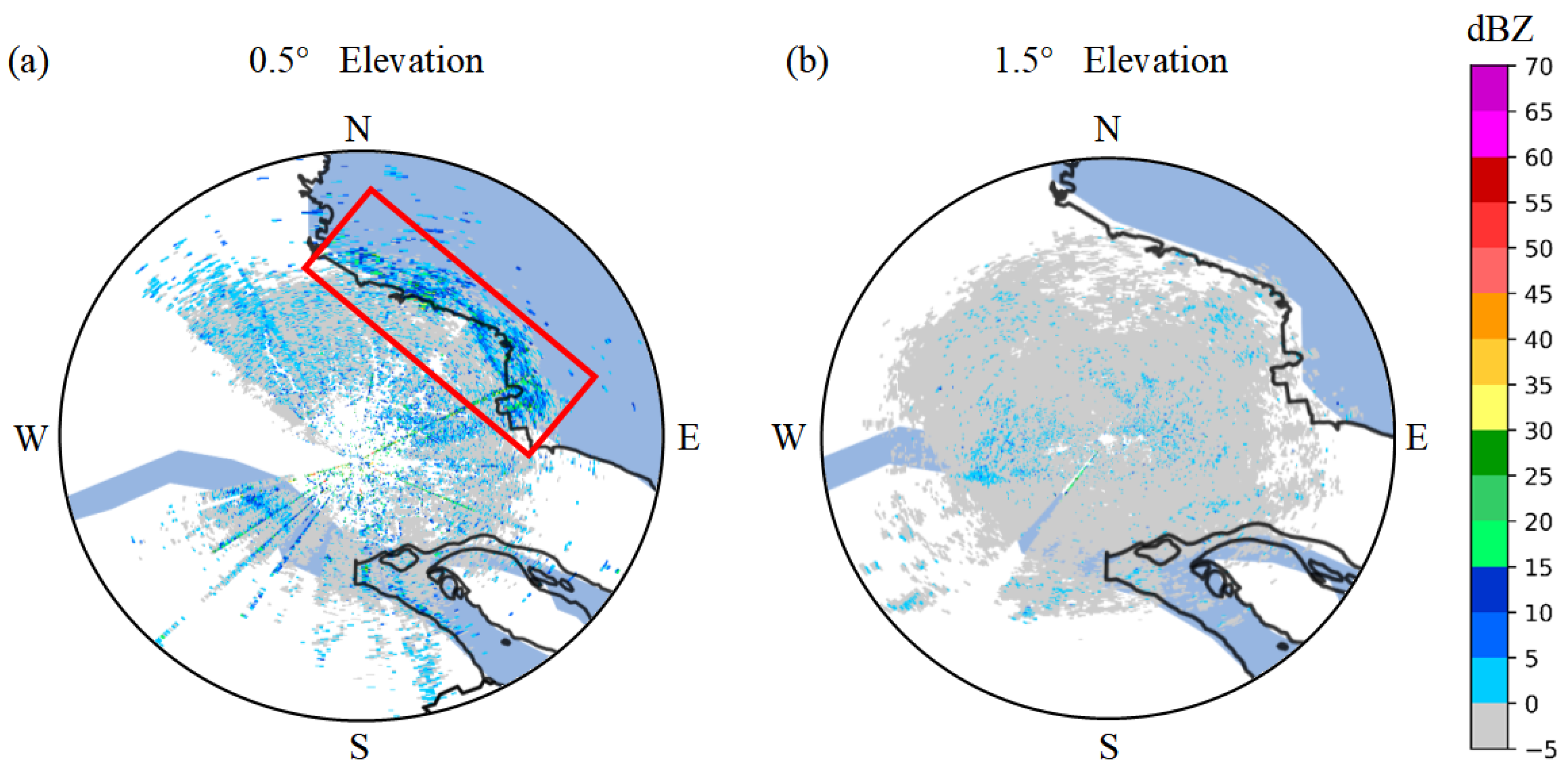
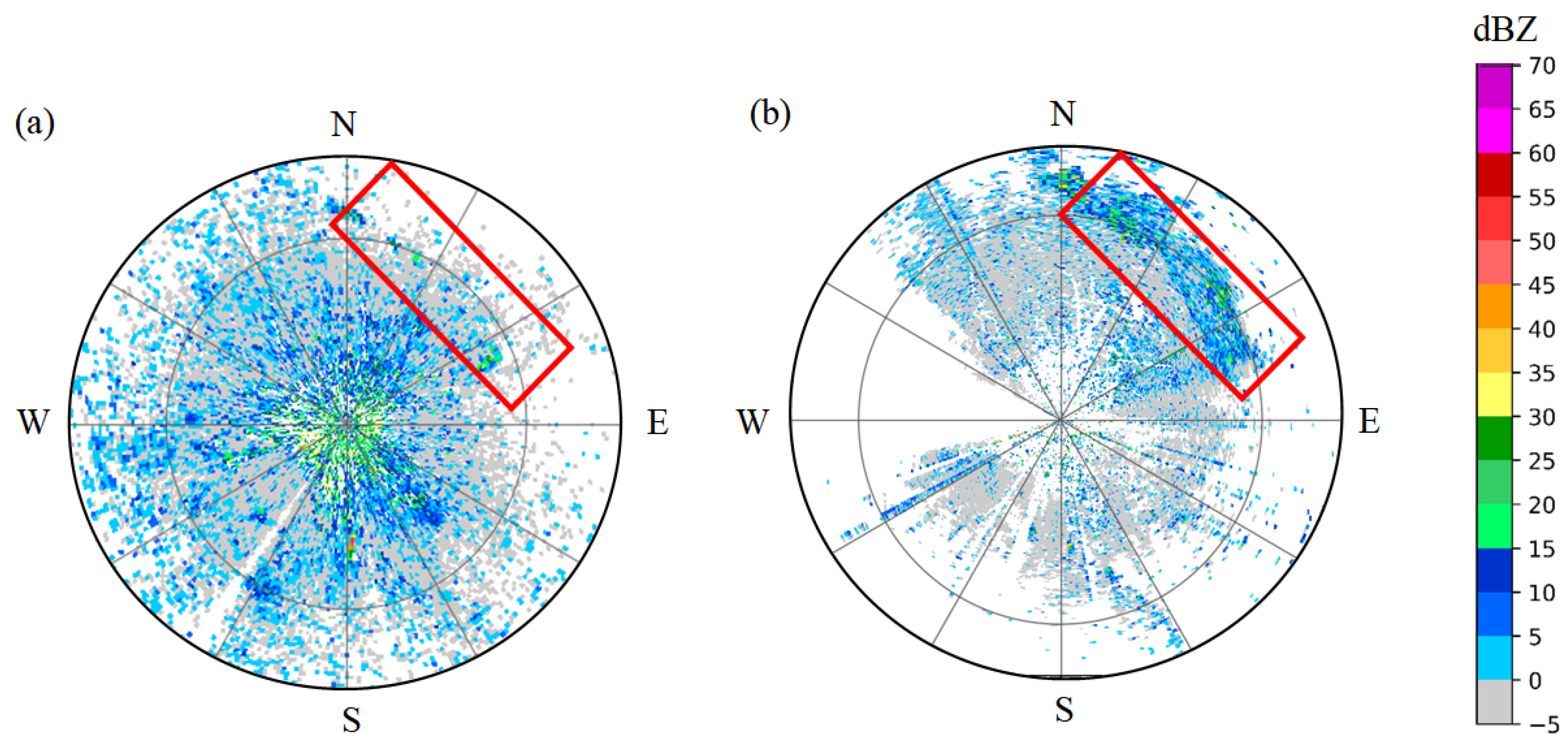


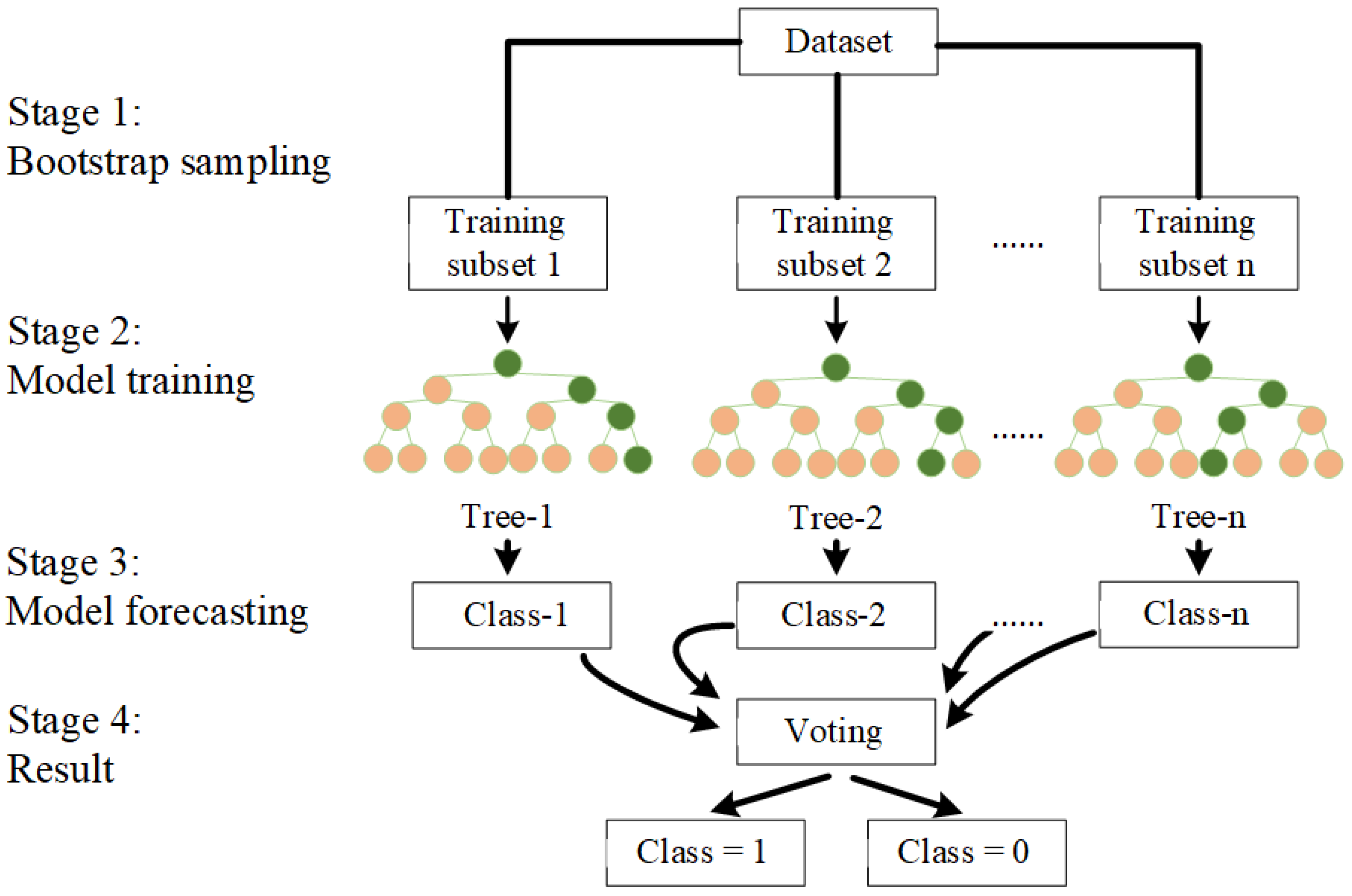

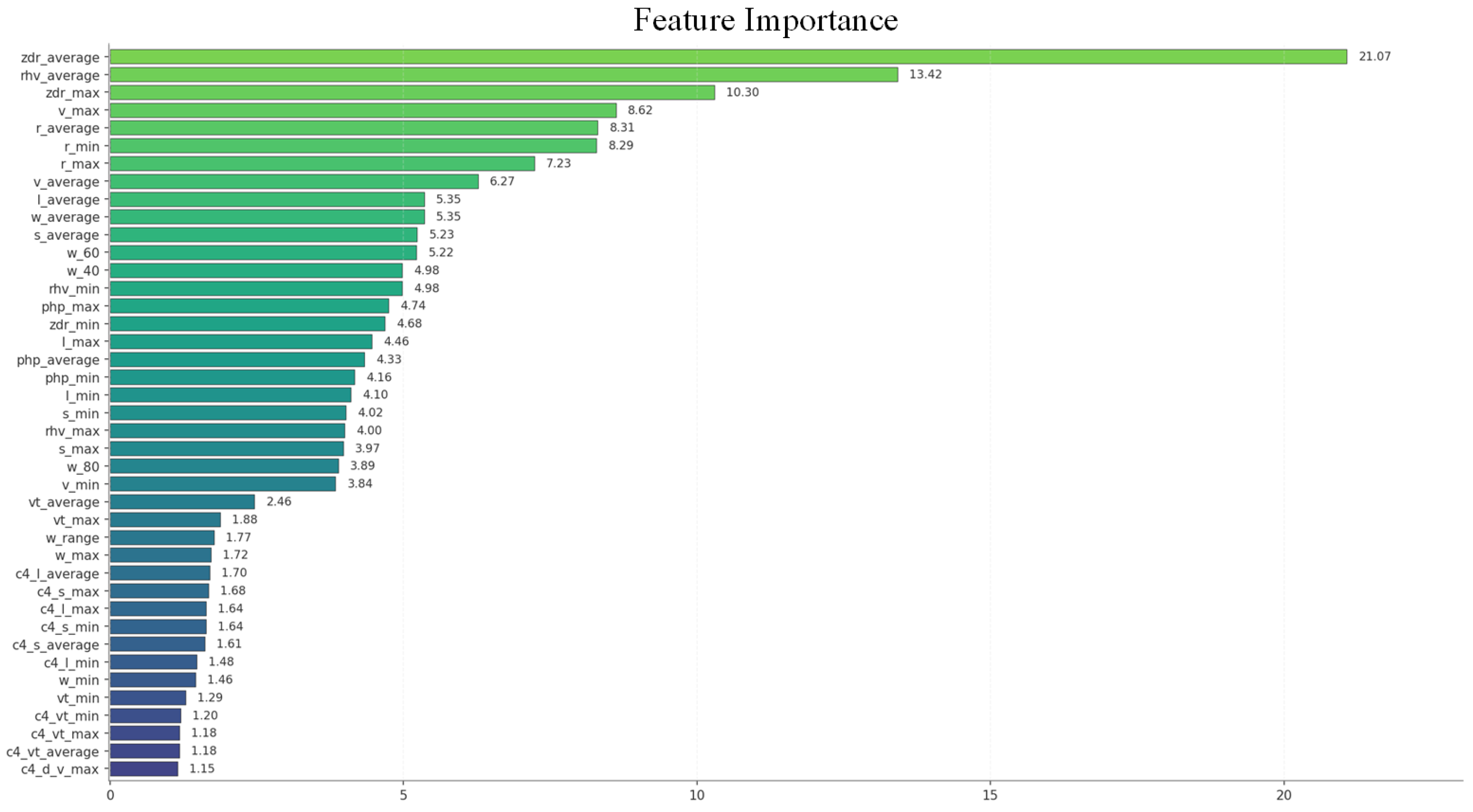
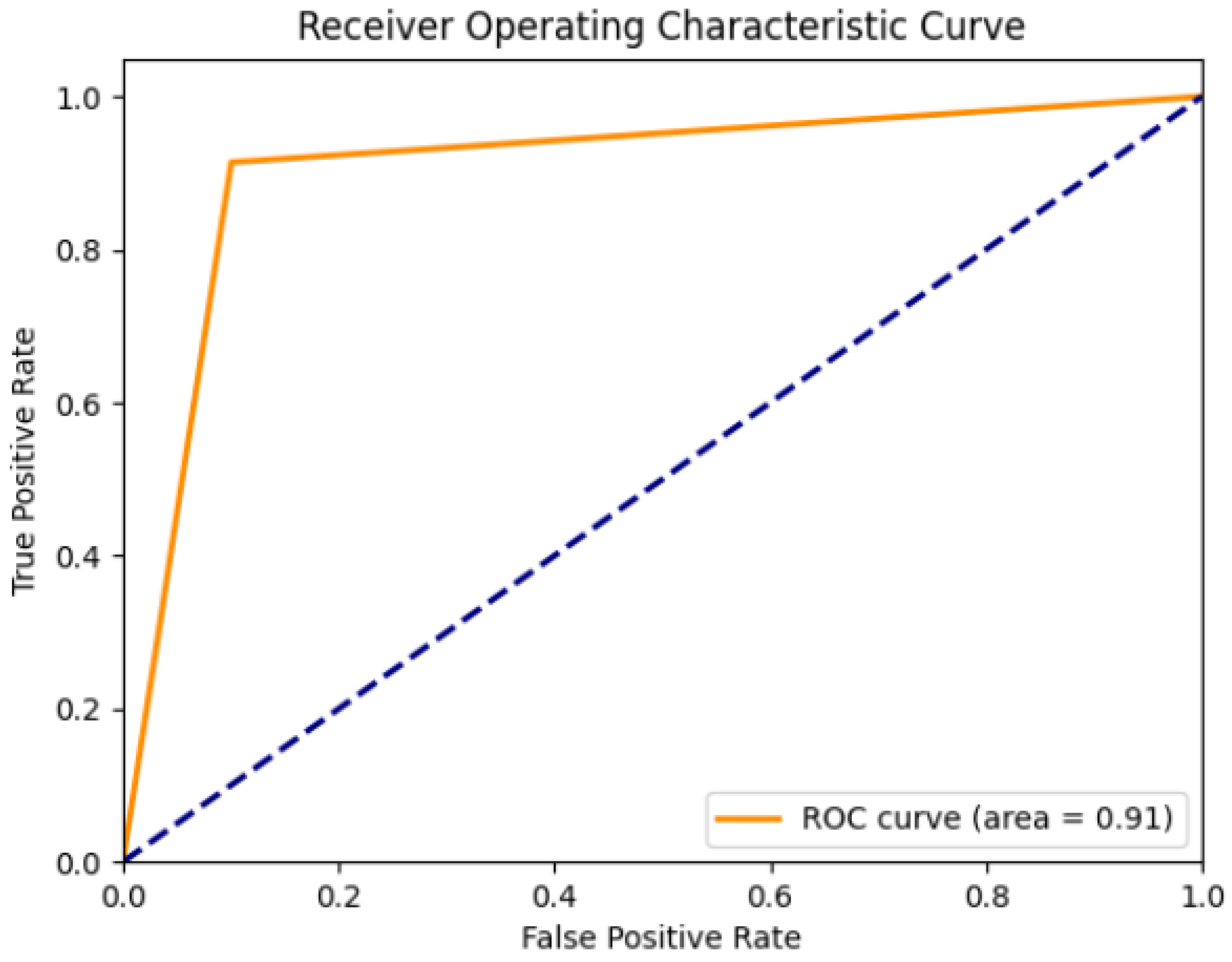

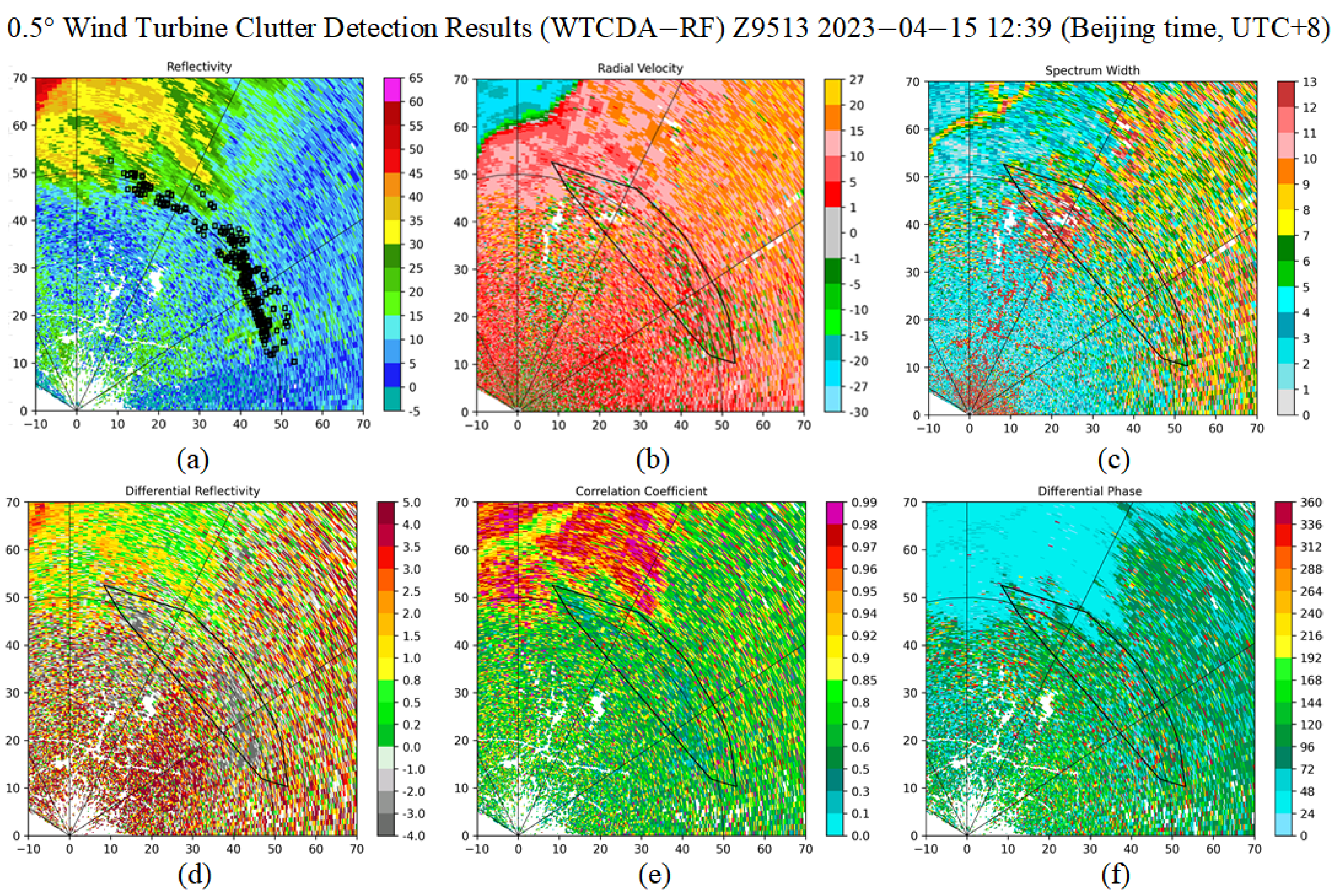

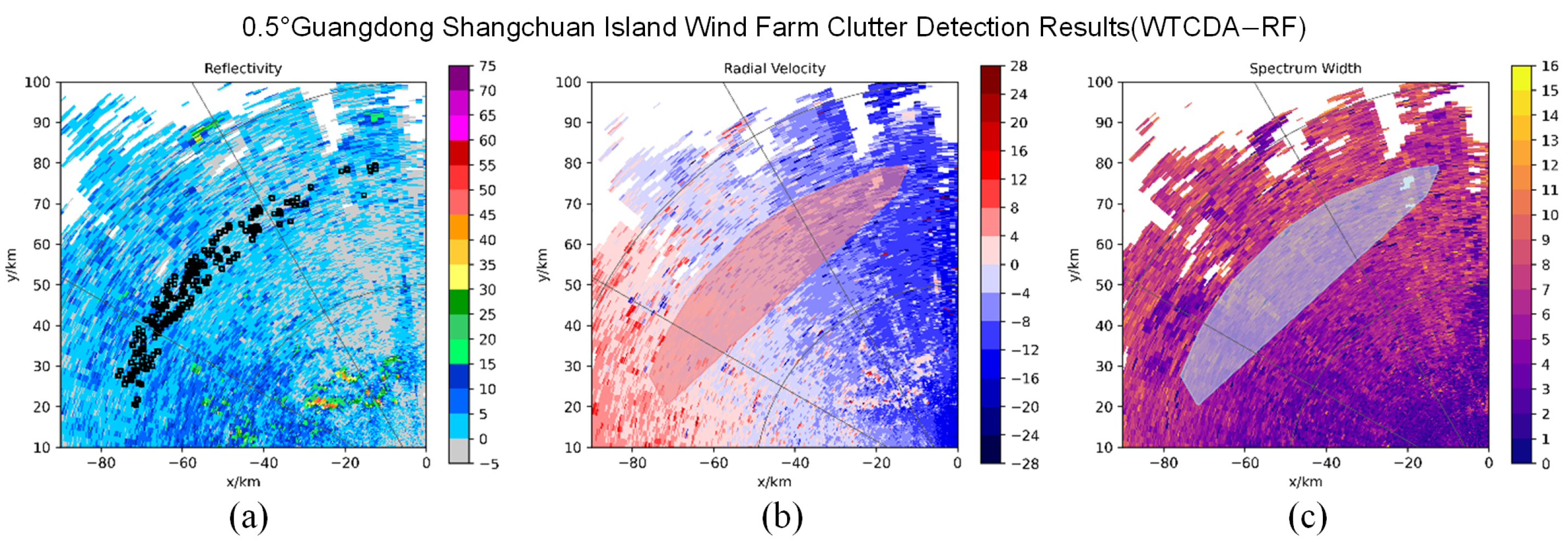
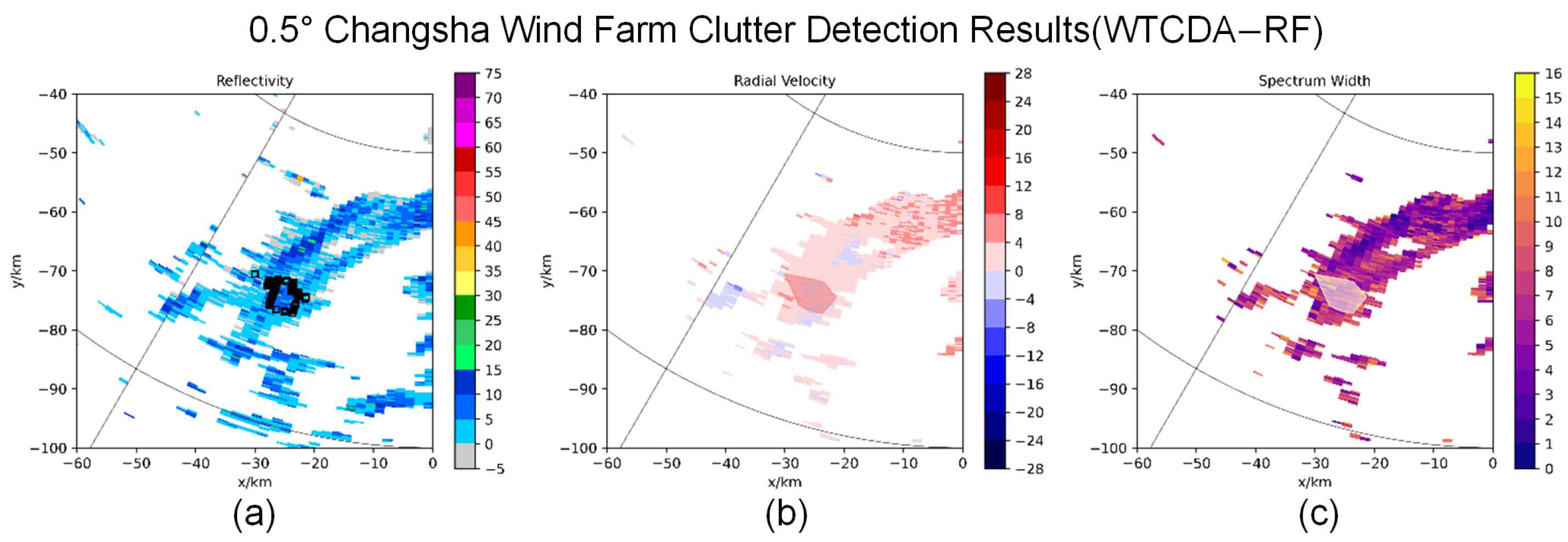

| Serial Number | Observation Model | Number of Elevation Angles | Volume Scan Cycle | Resolution Range | Adaptation Conditions |
|---|---|---|---|---|---|
| 1 | VCP215D | 12 | 6 min | 460 km 125 m | general precipitation (fine resolution) |
| 2 | VCP225D | 14 | 6 min | 460 km 125 m | general precipitation (fine resolution) |
| 3 | VCP216D | 15 | 6 min | 460 km 62.5 m | general precipitation (ultra-fine resolution) |
| 4 | VCP226D | 6 | 3 min | 330 km 62.5 m | general precipitation (rapid ultra-fine resolution) |
| Number of Elevation Angles | Volume Scan Cycle | ||
|---|---|---|---|
| Model predict class | Y (Yes WTC) | TP (True Positives) | FP (False Positives) |
| N (No WTC) | FN (False Negatives) | TN (True Negatives) | |
| Column Counts | Pc = TP + FN | NC = FP + TN |
| ACC | PRE | F1-Score | G-Mean | POD | FAR | CSI |
|---|---|---|---|---|---|---|
| 0.9092 | 0.8937 | 0.911 | 0.909 | 0.9289 | 0.1063 | 0.8365 |
| Weather Condition | POD | FAR | CSI |
|---|---|---|---|
| Light rain | 0.893 | 0.115 | 0.824 |
| Widespread light rain | 0.872 | 0.128 | 0.803 |
| Moderate rain | 0.832 | 0.152 | 0.782 |
| Widespread moderate rain | 0.817 | 0.168 | 0.767 |
| Severe convective | 0.793 | 0.179 | 0.744 |
| light rain | 0.839 | 0.147 | 0.789 |
| POD | FAR | CSI | |
|---|---|---|---|
| WTCDA-FL | 0.687 | 0.291 | 0.594 |
| WTCDA-CNN | 0.752 | 0.226 | 0.683 |
| WTCDA-RF | 0.790 | 0.182 | 0.748 |
Disclaimer/Publisher’s Note: The statements, opinions and data contained in all publications are solely those of the individual author(s) and contributor(s) and not of MDPI and/or the editor(s). MDPI and/or the editor(s) disclaim responsibility for any injury to people or property resulting from any ideas, methods, instructions or products referred to in the content. |
© 2025 by the authors. Licensee MDPI, Basel, Switzerland. This article is an open access article distributed under the terms and conditions of the Creative Commons Attribution (CC BY) license (https://creativecommons.org/licenses/by/4.0/).
Share and Cite
Zhang, F.; Gao, Y.; Zeng, Q.; Ren, Z.; Wang, H.; Chen, W. A Novel Wind Turbine Clutter Detection Algorithm for Weather Radar Data. Electronics 2025, 14, 3467. https://doi.org/10.3390/electronics14173467
Zhang F, Gao Y, Zeng Q, Ren Z, Wang H, Chen W. A Novel Wind Turbine Clutter Detection Algorithm for Weather Radar Data. Electronics. 2025; 14(17):3467. https://doi.org/10.3390/electronics14173467
Chicago/Turabian StyleZhang, Fugui, Yao Gao, Qiangyu Zeng, Zhicheng Ren, Hao Wang, and Wanjun Chen. 2025. "A Novel Wind Turbine Clutter Detection Algorithm for Weather Radar Data" Electronics 14, no. 17: 3467. https://doi.org/10.3390/electronics14173467
APA StyleZhang, F., Gao, Y., Zeng, Q., Ren, Z., Wang, H., & Chen, W. (2025). A Novel Wind Turbine Clutter Detection Algorithm for Weather Radar Data. Electronics, 14(17), 3467. https://doi.org/10.3390/electronics14173467








